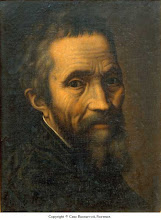Pieta


The following is a letter Michelangelo wrote about being harassing to get the work done.
"I spend my days supervising the construction of St. Peter's. The Vatican's financial superintendent keeps harassing me for a progress report. My response: your lordship, I am not obliged to, nor do I intend to, tell you anything. Your job is to keep the money rolling in, and out of the hands of thieves. I will see to the building."
This is part of a letter Michelangelo wrote to Giorgio Vasari about finishing the building.


The tombs of the Medici were of a completely new form. Michelangelo abandoned the traditional archicture style. Michelangelo renounced Christian traditions in order to portray Humanity to our eyes. He gave names to the statues of the sarcophagi: Dawn, Dusk, Day and Night. These smbols represent the suffering mankind.
Work on the Medici Tombs continue d long after Michelangelo went back to Rome in 1534.
d long after Michelangelo went back to Rome in 1534.

This comes from dangling from the ceiling–
I'm goitered like a Lombard cat
(or wherever else their throats grow fat)–
it's my belly that's beyond concealing,
it hands beneath my chin like peeling.
My beard points skyward, I seem a bat
upon its back, I've breasts and splat!
On my face the paint's congealing.Loins concertina'd in my gut,
I drop an arse as counterweight
and move without the help of eyes.Like a skinned martyr I abut
on air, and, wrinkled, show my fat.
Bow-like, I strain toward the skies.No wonder then I size
things crookedly; I'm on all fours.
Bent blowpipes send their darts off-course.Defend my labor's cause,
good Giovanni, from all strictures:
I live in hell and paint its pictures.Michelangelo Buonarroti
 One of the most famous stories of the Bible is the temptation of Adam and Eve. In this Biblical story, Satan is in the form of a serpent. He tempts Eve to eat of the forbidden fruit that will give her knowledge. She eats it and then gets Adam to eat. The following picture is Michelangelo's version of the story.
One of the most famous stories of the Bible is the temptation of Adam and Eve. In this Biblical story, Satan is in the form of a serpent. He tempts Eve to eat of the forbidden fruit that will give her knowledge. She eats it and then gets Adam to eat. The following picture is Michelangelo's version of the story.
 It seems at this point my blog is not allowing me to post pictures. Hopefully I can do that soon.
It seems at this point my blog is not allowing me to post pictures. Hopefully I can do that soon.










 Michelangelo Buonarroti was a painter, sculptor, architect, poet, and engineer. He was born on March 6, 1475 in a small village near Florence. He grew up in the city of Florence. At a young age, Michelangelo was apprenticed under Domenico Ghirlandaio. He was so talented that he did not have to pay the studio fees instead he was paid a small salary. After a few years at the apprenticeship, he enrolled in the sculpture studio of Bertoldo di Giovanni. This was normally a 3 year internship, but Michelangelo left after one year because his master could not teach him anything anymore. Michelangelo knew more than his master did. At the age of 15, he was invited to live and work in the home of Florence's civil leader, Lorenzo de Medici. After the death of Medici, Michelangelo left for Rome. Rome would be the start of many paintings and sculptors for Michelangelo. Through out his life, Michelangelo did several pieces of art (many will be shared in later posts) and he shared his talent with many. Michelangelo died on February 18, 1564 at the age of 88..
Michelangelo Buonarroti was a painter, sculptor, architect, poet, and engineer. He was born on March 6, 1475 in a small village near Florence. He grew up in the city of Florence. At a young age, Michelangelo was apprenticed under Domenico Ghirlandaio. He was so talented that he did not have to pay the studio fees instead he was paid a small salary. After a few years at the apprenticeship, he enrolled in the sculpture studio of Bertoldo di Giovanni. This was normally a 3 year internship, but Michelangelo left after one year because his master could not teach him anything anymore. Michelangelo knew more than his master did. At the age of 15, he was invited to live and work in the home of Florence's civil leader, Lorenzo de Medici. After the death of Medici, Michelangelo left for Rome. Rome would be the start of many paintings and sculptors for Michelangelo. Through out his life, Michelangelo did several pieces of art (many will be shared in later posts) and he shared his talent with many. Michelangelo died on February 18, 1564 at the age of 88..